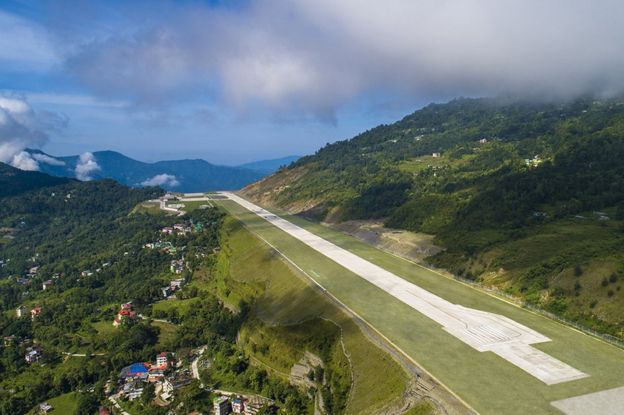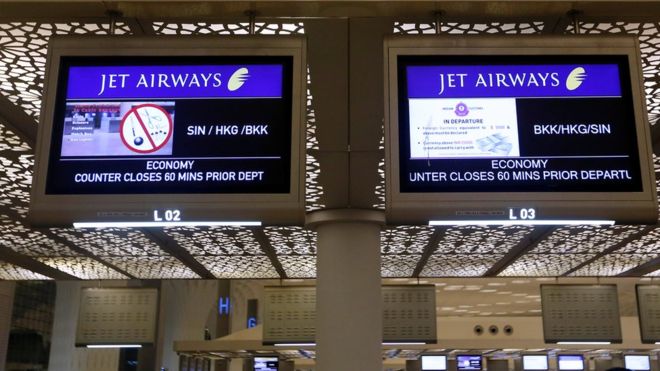Is India’s Prime Minister, Narendra Modi, correct to claim credit for an airport building boom in his country?
The prime minister tweeted this week that India now had 100 airports and 35 of these had been completed in the past four years, after his BJP government came to power.
In a dig at the opposition parties, he said: “In the 67 years since independence, up to 2014, there were only 65 airports. That’s on average one airport built each year.”
These figures would suggest that under the current administration, airports have been built at a rate of almost nine per year.
So, are these claims backed up by the official figures?
Passenger demand
The Airports Authority of India, which is responsible for civil aviation infrastructure, currently lists 101 airports on its website.
India’s Directorate General of Civil Aviation (DGCA) – the body that regulates civil aviation – also has a figure of 101 domestic airports as of 31 March 2018.
However, looking back at earlier years, the picture gets more complicated.
The DGCA has the following figures for domestic airports:
- In 2015, there were 95 airports, of which 31 were “non-operational”
- In 2018, 101 airports, of which 27 are “non-operational”
This suggests an increase of only six new airports since 2015 or an overall increase of 10 “operational” airports.
This is significantly fewer than the 35 since 2014 claimed by Mr Modi.

At an aviation summit in Delhi this month, India was praised for its airport building by Alexandre de Juniac, the head of the International Air Transport Association (IATA).
His exact remarks were: “What has happened with India’s airport infrastructure over the last decade is amazing.”
That would include the period before the BJP came to power, in 2014.
It’s also worth saying that any airports opened in the past four years are likely to have been started by previous governments, even if they were ultimately completed under the present administration.
“The need to assess likely passenger demand, acquire suitable land and secure adequate finance usually means that airports are planned years in advance of opening,” says Lucy Budd, an expert on air transport infrastructure, at Loughborough University, in the UK.
Aviation boom
There’s little doubt that India will need much more airport capacity. And the current BJP government does have ambitious plans to expand aviation infrastructure.
Last year, it launched a scheme known as Udan (“flight” in Hindi) to extend the regional air network and encourage more traffic between underserved destinations and the country’s megacities.
Earlier this year, the Aviation Minister, Jayant Sinha, spoke of India needing 150 to 200 airports by 2035.
India has gradually liberalised its aviation sector over more than two decades.
Passenger numbers have been surging and there’s been fevered competition between carriers in the market, leading to price wars in recent years.
Rail is still the preferred mode of long-distance travel for many Indians because it is cheap, although it can be slow and not that comfortable.
However, Lucy Budd says: “The rapidly growing number of middle-class consumers in India, who have higher levels of discretionary income and who may place a greater emphasis on the value of time, are helping to stimulate the current growth in demand for domestic air routes.”
In fact, the two-hour flight between the capital, Delhi, and the commercial hub of Mumbai is now classed as one of the busiest routes in the world.
Capacity constraints
Over the next 20 years, traffic in India is predicted to exceed 500 million air passenger journeys a year, according to the International Air Transport Association (IATA).
But it pointed out in a recent report that the country currently ranked relatively low in terms of airport density (the number of airports per million of population).
In order for the sector’s growth potential to be met, IATA says, it “will require the right type of infrastructure to be put into place, at the right time and in the right place”.
In fact, some analysts believe the growth in passenger numbers is such that the biggest cities will need second airports in the near future.
“By 2030, India will need second airports in all of the six major cities (by that stage Mumbai may even be approaching the need for a third),” says Binit Somaia, South Asia director of the aviation consultancy group CAPA.
“And virtually all of the 40 largest airports in India’s other cities will have become saturated and will require new capacity.”
A report by CAPA earlier this year forecast that India’s airport system would “exceed its structural capacity by 2022”.
But the report does commend “positive signs of a strong revival in airport capacity initiatives since 2016” – with plans not just for new airports but also expansion projects at existing ones as well as new ways to finance these developments.

